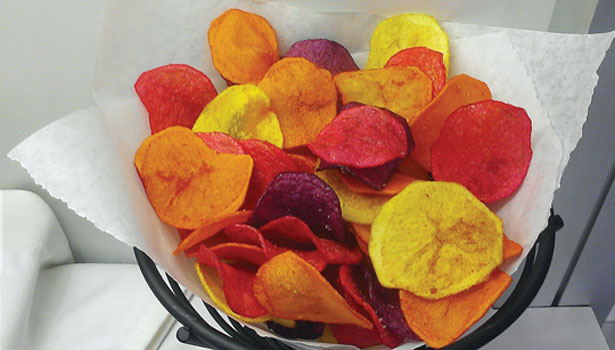Color Considerations: Natural versus Synthetic
Food and beverage formulators face new performance and cost-in-use considerations with new natural colorants replacing synthetic options.


At the end of 2013, the FDA approved the use of Spirulina extract as a naturally derived blue colorant for confectionery and chewing gum. Permission for wider usage is currently being investigated.

Visual appeal -color- is the first contact a consumer has with a product prior to consumption, making the consumer-driven trend away from synthetic colorants a huge challenge.

When it comes to fooling the eye, color is critical; it affects how consumers perceive flavor and even texture.

Fruit extracts address consumer interest in natural sweetening and coloring. The brown color of the coloring extracts is mainly determined by the polyphenols naturally occurring in apples.

New sources of natural browns now replicate the bolder shades of certified colorants, while allowing for a clean label and reduction or elimination of the controversial 4-MEI compound.
SOURCE: SENSIENT COLORS & FLAVORS






When new beverage company Golazo Inc. entered the market offering “healthier natural sports and energy drinks,” it made the introduction with several flavors of beverages designed to provide hydration, electrolyte replacement and quick energy.
The company’s philosophy called for a clean ingredient statement, and it further emphasized its commitment to the natural category by working with the Non-GMO Project to certify its formulations. (The Non-GMO Project is a Bellingham, Wash.-based, non-profit organization “committed to preserving and building sources of non-GMO products, educating consumers and providing verified non-GMO choices.”)
This approach was more than a sales strategy. Golazo believes that, in the functional beverage category, there must be a commitment to natural ingredients, clean labels, proven functionality and palatability. To that end, Golazo chose to use only colorants derived from natural sources. In developing its products, the company initially ran into some difficulties finding the natural colors that could satisfy all of the necessary performance criteria.
Fortunately, the R&D team at Golazo ultimately found colorant suppliers that could be relied upon for recommendations and technical support. In this way, the company was able to team up with the suppliers’ experts in meeting the challenge of developing formulations that met its complicated marketing criteria and specifications.
Such choices are being made by an increasing number of companies, as consumers demand cleaner labels.
A great deal has been written over the past few years about food colorants, particularly those derived from natural sources (referred to here as “natural colorants”). After all, typically, the visual appeal—color—is the very first contact a consumer has with a food or beverage product prior to consumption. This clean label paradigm shift results from a consumer-driven trend within the food and beverage industries to move away from synthetic ingredients. It has been particularly emphatic concerning synthetic food colorants.
Fake Out
As synthetic colorants are replaced by natural colorants, today’s food and beverage formulator must deal with differences—often stark differences—in performance and cost of use. Also, typical of all issues related to food and beverage developing and manufacturing, regulatory frameworks influence the playing field.
On the basis of FDA regulation, the “natural color” terminology is not completely accurate (or even, for that matter, permitted). This is further complicated by the continuing debate within the food industry as to what, exactly, constitutes a “natural” ingredient or product on the whole.
For example, as previously mentioned, according to strict FDA definition, there is no such thing as a “natural color”—unless the color is indeed “natural” to the application. For example, if strawberry juice is used to color strawberry preserves, then the color is natural to the food. However, if strawberry juice is used to color strawberry-flavored yogurt, then the color is not natural to the food. Even if raspberry juice were used to color strawberry preserves, it could not be termed “natural coloring.”
One result of this lack of clarity is that manufacturers might make claims that add to the confusion and potentially run afoul of regulatory intent. Even when natural colorants are used in a formulation that contains only natural ingredients, it is not permitted to make an “all natural” or “no artificial colors” claim anywhere on the package. This is in addition to the regulatory designation strictly limiting the listing, as such, of a “natural” colorant on the ingredient label.
With recent and increasing disagreements over the use of the label phrase “all natural” leading to court cases attempting to force a definition in the absence of a firm regulatory guidance, there is greater focus on colorants and their applications. A California court recently threw out a class action lawsuit brought against top-selling yogurt maker Chobani (Kane vs. Chobani Inc.) for allegedly mislabeling its products as “all natural.” (The case did nothing to clarify the definition, as it was dismissed on other technical grounds.)
In other regulatory matters, caramel colorants have drawn renewed scrutiny for the presence of 4-MEI (4-methylimidazole), a side product (and suspected carcinogen) in the production of caramel food colorants. (See “Healthful Colors: Where Palette Meets Palate,” bit.ly/1qOOWlU.) Caramel colorant manufacturers responded to the concern by revising production methods to reduce the presence of the 4-MEI to below regulatory thresholds.
Other companies have offered products from alternative sources that provide the same type of color shades, eliminating or greatly reducing concern about 4-MEI. A new colorant, a natural brown shade described as being from vegetable juice sources, is said to replicate the bold shades of certified colorants. It offers a clean label, a reduction or elimination of 4-MEI, and it is available in colors ranging from buttery yellow-brown to deep auburn.
Keeping it Natural
There are a multitude of challenges to creating and using natural colorants, from the making of the ingredient itself all the way to the consumer’s table. Some raw materials can vary in appearance and color content due to seasonal variations in growing conditions. Historically, colorants have been added to food and beverage products in an effort to standardize product appearance against these seasonal variations. They may also be used to reinforce the characteristic color and to improve the overall palatability of a food or beverage by enhancing its appearance.
Processing can reduce or degrade the content of various substances in the food or beverage, usually impacting the naturally occurring color first. Some food or beverage manufacturers, especially those in the organic and all-natural product categories, can be reluctant to rely on the use of any color additives at all, even naturally derived ones, to standardize the appearance of their products. It is more in keeping with their product and business philosophies to allow the product to vary from season to season, as the raw materials themselves vary. Others see natural food coolants as a means to improve or standardize appearance while avoiding the use of synthetic food colorants.
The latest trend, however, is to make use of new colorant technology to create products that can better compete with the mainstream offerings of the larger companies. In this case, standardized appearance is highly important. Moreover, science has well established the effect visual appeal has on flavor perception. For Golazo, the importance of palatability led to the decision to use natural colorants to enhance appearance.
The historical controversy over the definition of what constitutes a natural product or ingredient has been re-energized recently, partly due to consumer confusion over how to interpret label declarations. In the natural colorant area, for instance, beta-carotene is a highly recognizable coloring additive that is available in both naturally derived and nature-identical forms. It provides a yellow to yellow-orange color and is also a source of vitamin A.
Seeing Orange
The naturally derived form of beta-carotene can be extracted from sources such as carrots, palm oil, a salt-tolerant algae (Dunaliella salina) or a fungus (Blakeslea trispora). The nature-identical form is produced by a synthesis from chemical precursors. Some find the source of the nature-identical form objectionable and insist that only beta-carotene derived from natural sources is “natural.” From a regulatory perspective—and most agree from a functionality perspective as well—there has been no perceivable difference yet determined.
Color manufacturers and their customers have historically faced challenges in the application of natural food colorants. It is generally accepted that, with a few important exceptions, natural colorants are more susceptible to degradation by heat, light, oxygen, pH and interactions with other materials in the formulation. There also is the historical perception that natural colorants are not as vivid as synthetic food dyes and so may be less visually appealing. Solubility can also be an issue.
While some natural colorants are readily soluble in water (such as anthocyanins), others—such as carotenoids—are soluble in fats. Others, such as curcumin, the coloring principle in turmeric, are only sparingly soluble in ether. Also, it is generally accepted that there is a price premium associated with the use of natural colorants as replacements for synthetics.
While progress has been made on performance issues over the last 20 years, much remains to be resolved. For instance, 20 years ago, it was possible to formulate beverages using beta-carotene as the colorant. In these cases, the beta-carotene was combined with an emulsifier to allow successful dispersion of the oil-soluble carotenoid in water.
However, in some beverage applications, either the processing conditions or interactions with other ingredients could destabilize the emulsion, leading to separation of the beta-carotene from the solutions. This separation was often manifesting as a colored ring in the neck of the container. Today, there are a number of more robust beta-carotene formulations available that address this issue.
In some cases, these types of emulsions still tend to lend a cloudy or turbid appearance. This is due to the nature of the emulsion. Because of this, there was limited use of these types of color preparations in the past. Luckily, recent ingredient science advancements in the use of natural beta-carotene as a colorant have allowed for the introduction of carotenoid emulsions that use more modern technology to produce clear emulsions. In just the past couple of years, this has further extended the use of these types of natural colorants in beverage applications.
More recent marketing and consumer preferences have further complicated the use of natural colorant formulations. Consider the oil-soluble carotenoids described above that have been formulated to give stable emulsions in beverage applications. According to FDA regulation, processors need not declare the carriers and processing aides used to make the colorant formulation, as long as they contribute no functionality beyond color stabilization in the finished product.
However, these ingredients might not meet other requirements, such as natural or non-GMO. To satisfy these criteria, it would be necessary to survey colorant manufacturers to find the formulation that fits all the necessary criteria.
Carotenoid emulsions are an example of the use of complementary ingredients to extend the use of natural colorants into new and more challenging applications. This combination of known food ingredients is fertile ground for development of new ways to use natural colorants. Companies with multiple ingredient platforms can have a distinct advantage in developing these types of ingredient combinations.
For example, a company with expertise in natural colorants and in ingredients with antioxidant functionality can produce combinations of these two categories that can extend the shelflife of natural colorants through the prevention of degradation due to reaction with oxygen. A company with expertise in natural colorants and in hydrocolloids can produce combinations that extend the useful applications of natural colorants by pairing them with ingredients that enhance solubility or dispersibility.
Color to Dye For
|
Powerfully Natural Color
 As the use of natural pigments increases, so too does the merging of color and functionality. Purples and violet from purple corn, berries and currants, and reds and oranges from beta-carotene, lycopene, astaxanthin and the powerful cellular antioxidant tocotrienol (found in the common natural plant colorant, annatto) all have been recently joined by the vivid natural blues and greens derived from the phycocyanin pigments in the cyanobacteria microalgae known as Spirulina. As the use of natural pigments increases, so too does the merging of color and functionality. Purples and violet from purple corn, berries and currants, and reds and oranges from beta-carotene, lycopene, astaxanthin and the powerful cellular antioxidant tocotrienol (found in the common natural plant colorant, annatto) all have been recently joined by the vivid natural blues and greens derived from the phycocyanin pigments in the cyanobacteria microalgae known as Spirulina.
But, these compounds have proven to play critical roles beyond protecting cells from free-radical forms of oxygen that corrupt cellular DNA. They have been identified as having distinct metabolic functions, ranging from anti-inflammation to energy production. And, the antitumorogenesis effects of the brilliant yellow/gold curcumin have elevated the compound to being one of the most upward-trending ingredients of the past couple of years.
While the amounts used in coloring foods might not individually reach a level of functionality that could allow such claims, the cumulative effect is not to be ignored. Most of all, the door is open for processors to include such functional amounts in products while, in turn, taking advantage of the ingredients’ distinctive and vibrant colorant properties.
|
While synthetic colorants have tended to be less expensive and easier to use, one commonly mentioned issue is the dustiness of dye powders. A small amount of highly concentrated synthetic dye powder can create a fairly large cleanup or cross-contamination issue. One color supplier resolved this issue by introducing technology allowing the production of precisely unitized packets of synthetic dyes in food-grade, water-soluble packaging material.
This unitized packet technology can be applied to natural colorants, as well. It allows the handling and use of these highly colored powders, in predetermined dosages, without color transfer to hands or production surfaces.
Similar gains have been made concerning the highly tricky discipline of coloration of confectionery compound coatings. This area had been complicated in the past by the need to incorporate small amounts of colorant into a mass of confection. One ingredient maker recently introduced solid, highly colored bits consisting of colorant and tempered cocoa butter.
A selection of base colors in both synthetic and natural varieties are available, and a color chart describes ways to blend the various shades to achieve a target color. These novel products are intended to allow food professionals to make their own colorfully personalized creations with more ease and in less time.
One of the most frequently mentioned challenges to the broader use of natural colorants is the dearth of functional green and blue hues. Chlorophyll is approved for only limited use in the U.S. and offers an option to achieve green hues. There is potential for expansion of its permitted uses. Mars had petitioned the FDA for use of Spirulina (a type of blue-green algae) extract as a naturally derived blue colorant in confectionery and chewing gum. This limited approval was granted in late 2013.
A global food colorant supplier has been working with the FDA to gain broader approval for the use of green and blue preparations based on the blue-green cyanobacteria known as Spirulina (either Arthrospira platensis or Arthrospira maxima). The FDA just announced plans to issue its approval in April of this year. While Spirulina had been known for some time in the U.S. as a dietary supplement, Spirulina extracts have been used in Europe for years. There already is an extensive body of application information and an infrastructure for production and supply of the newly approved colorants.
Biologically Active
Another area of potential interest is the biological activity of many natural-coloring compounds. There is a growing body of work that demonstrates positive biological activity of carotenoids, anthocyanins and other classes of natural coloring materials. The industry continues to see the introduction of more preparations of these materials as direct health and nutritional supplements. The approval of Spirulina only adds to this functional marketing capacity of some colorants.
When it comes to the coloration of foods and beverages, however, such an approach still can be quite a tricky matter. This is because supplements can deliver much higher doses of the active ingredients.
Typical use levels of natural colorants in foods and beverages are low and, thus, are not likely to have—by themselves and in isolation—very much short-term health benefit. However, nutritionally, the argument can be made that even these low doses of biologically active natural colorants contribute to an overall micronutrient load that benefits the consumer.
As more companies venture to replace synthetic colorants with natural colorants, they tend to adopt either of two positions: They realize that natural colorants can be quite attractive, vivid and functional, or they adjust their expectations of appearance to accommodate a marketing strategy or specific customer preference. Either way, the appeal to knowledgeable consumers is increased.
The cost of natural colorants compared to synthetics has been a historical challenge that will probably not be fully resolved. As natural colorants become more prevalent, there is some chance costs will come down due to increased utilization. The use of newer processing and formulation technologies can, in some cases, reduce the amount of colorant needed to achieve a desired result. This in turn can reduce cost in use.
The food and beverage industries will almost certainly continue to make choices between functionality, cost and consumer preference when choosing colorants. Increased advances in ingredient science and technology, and the broadening of natural coloring options, will hopefully render such choices much easier to make.
Looking for a reprint of this article?
From high-res PDFs to custom plaques, order your copy today!












